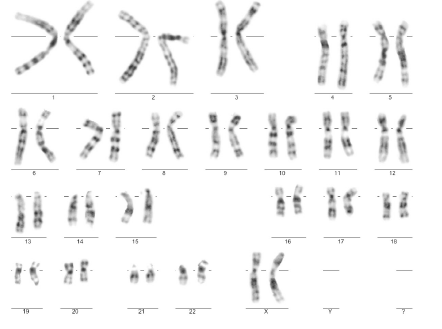Paciente masculino con cariotipo 46 XX negativo para el gen SRY y sin ambigüedad genital: reporte de un caso
Resumen
En la mayoría de los casos, la diferenciación sexual masculina ocurre con la participación del gen SRY. Sin embargo, se pueden presentar otros genotipos excepcionales, como en el caso que se presenta en este reporte.
Se trata de un paciente adulto de sexo masculino atendido en el Servicio de Paternidades del Instituto de Genética de la Universidad Nacional de Colombia. Se le hicieron los análisis del gen de la amelogenina y de repeticiones cortas en tándem (Short Tandem Repeat, STR) específicas para el gen SRY con estuches comerciales de identificación humana, así como los de cariotipo convencional e hibridación in situ fluorescente del SRY, y el estudio de microdeleciones del cromosoma Y mediante reacción en cadena de la polimerasa (PCR). Se le hizo la evaluación clínica y se le brindó asesoramiento genético.
El paciente no presentaba ambigüedad genital, su cariotipo era 46 XX, y el perfil molecular era negativo para el gen SRY y positivo para el ZFY. Se le diagnosticó un trastorno de diferenciación sexual 46 XX testicular no sindrómico, una rara condición genética.
Solo el 20 % de los pacientes con este diagnóstico son negativos para SRY y exhiben perfiles moleculares diversos. La información disponible parece indicar que el ZFY está relacionado con la diferenciación sexual masculina, aún en ausencia del gen SRY.
Descargas
Referencias bibliográficas
Biason-Lauber A. Control of sex development. Best Pract Res Clin Endocrinol Metab. 2010;24:163-86. https://doi.org/10.1016/j.beem.2009.12.002
Sinclair AH, Berta P, Palmer MS, Hawkins JR, Griffiths BR, Smith MJ, et al. A gene from the human sex-determining region encodes a protein with homology to a conserved DNA binding motif. Nature. 1990;346:240-4. https://doi.org/10.1038/346240a0
Li TF, Wu QY, Zhang C, Li WW, Zhou Q, Jiang WJ, et al. 46,XX testicular disorder of sexual development with SRY-negative caused by some unidentified mechanisms: A case report and review of the literature. BMC Urol. 2014;14:104. https://doi.org/10.1186/1471-2490-14-104
De la Chapelle A, Hortling H, Niemi M, Wennström J. XX sex chromosomes in a human male. First case. Acta Med Scand. 1964;175(Suppl.412):25-8.
Vorona E, Zitzmann M, Gromoll J, Schüring A, Nieschlag E. Clinical, endocrinological, and epigenetic features of the 46,XX male syndrome, compared with 47,XXY Klinefelter patients. J Clin Endocrinol Metab. 2007;92:3458-65. https://doi.org/10.1210/jc.2007-0447
Rizvi AA. 46, XX man with SRY gene translocation: Cytogenetic characteristics, clinical features and management. Am J Med Sci. 2008;335:307-9. https://doi.org/10.1097/MAJ.0b013e31811ec1b4
Bashamboo A, Bhatnagar S, Kaur A, Sarhadi VK, Singh JR, Ali S. Molecular characterization of a Y-derived marker chromosome and identification of indels in the DYS1 region in a patient with stigmata of Tuner syndrome. Current Science. 2003;84:219-24.
Griffiths R, Tiwari B. Primers for the differential amplification of the sex-determining region Y gene in a range of mammal species. Mol Ecol. 1993;2:405-6. https://doi.org/10.1111/j.1365-294X.1993.tb00034.x
Simoni M, Bakker R, Krausz C. EAA/EMQN best practice guidelines for molecular diagnosis of y-chromosomal microdeletions. State of the art 2004. Int J Androl. 2004;27:240-9. https://doi.org/10.1111/j.1365-2605.2004.00495.x
Dauwerse JG, Hansson KB, Brouwers AA, Peters DJ, Breuning MH. An XX male with the sex-determining region Y gene inserted in the long arm of chromosome 16. Fertil Steril. 2006;86:463.e1-5. https://doi.org/10.1016/j.fertnstert.2005.12.062
Zakharia G, Krauss DJ. Sex reversal syndrome (XX male). Urology. 1990;36:322-4. https://doi.org/10.1016/0090-4295(90)80238-I
Majzoub A, Arafa M, Starks C, Elbardisi H, Al Said S, Sabanegh E. 46 XX karyotype during male fertility evaluation; case series and literature review. Asian J Androl. 2017;19:168-72. https://doi.org/10.4103/1008-682X.181224
Sutton E, Hughes J, White S, Sekido R, Tan J, Arboleda V, et al. Identification of SOX3 as an XX male sex reversal gene in mice and humans. J Clin Inves. 2011;121:328-41. https://doi.org/10.1172/JCI42580
Meeks JJ, Weiss J, Jameson JL. Dax1 is required for testis determination. Nat Genet. 2003;34:32-3. https://doi.org/10.1038/ng1141
Rajender S, Rajani V, Gupta N, Chakravarty B, Singh L, Thangaraj K. SRY-negative 46,XX male with normal genitals, complete masculinization and infertility. Mol Hum Reprod. 2006;12:341-6. https://doi.org/10.1093/molehr/gal030
Tian L, Chen M, Peng JH, Zhang JW, Li L. Clinical characteristics, cytogenetic and molecular findings in patients with disorders of sex development. J Huazhong Univ Sci Technolog Med Sci. 2014;34:81-6. https://doi.org/10.1007/s11596-014-1235-y
Vetro A, Ciccone R, Giorda R, Patricelli M, Della Mina E, Forlino A, et al. XX males SRY negative: A confirmed cause of infertility. J Med Genet. 2011;48:710-2. https://doi.org/10.1136/jmedgenet-2011-100036
Xia XY, Zhang C, Li TF, Wu QY, Li N, Li WW, et al. A duplication upstream of SOX9 was not positively correlated with the SRY-negative 46,XX testicular disorder of sex development: A case report and literature review. Mol Med Rep. 2015;12:5659-64. https://doi.org/10.3892/mmr.2015.4202
Su H, Lau Y. Demonstration of a stage-specific expression of the ZFY protein in fetal mouse testis using anti-peptide antibodies. Mol Reprod Dev. 1992;33:252-8. https://doi.org/10.1002/mrd.1080330304
Palmer MS, Berta P, Sinclair AH, Pym B, Goodfellow PN. Comparison of human ZFY and ZFX transcripts. Proc Natl Acad Sci USA. 1990;87:1681-5.
Slattery JP, Sanner-Wachter L, O’Brien SJ. Novel gene conversion between X-Y homologues located in the nonrecombining region of the Y chromosome in Felidae (Mammalia). Proc Natl Acad Sci USA. 2000;97:5307-12. https://doi.org/10.1073/pnas.97.10.5307
De la Chapelle A, Hästbacka J, Korhonen T, Mäenpää J. The etiology of XX sex reversal. Reprod Nutr Dev. 1990;(Suppl.1):39s-49.
Algunos artículos similares:
- Andrea Casas-Vargas, Liza M. Romero, William Usaquén, Sara Zea, Margarita Silva, Ignacio Briceño, Alberto Gómez, José Vicente Rodríguez, Diversidad del ADN mitocondrial en restos óseos prehispánicos asociados al Templo del Sol en los Andes orientales colombianos , Biomédica: Vol. 37 Núm. 4 (2017)

| Estadísticas de artículo | |
|---|---|
| Vistas de resúmenes | |
| Vistas de PDF | |
| Descargas de PDF | |
| Vistas de HTML | |
| Otras vistas | |

























